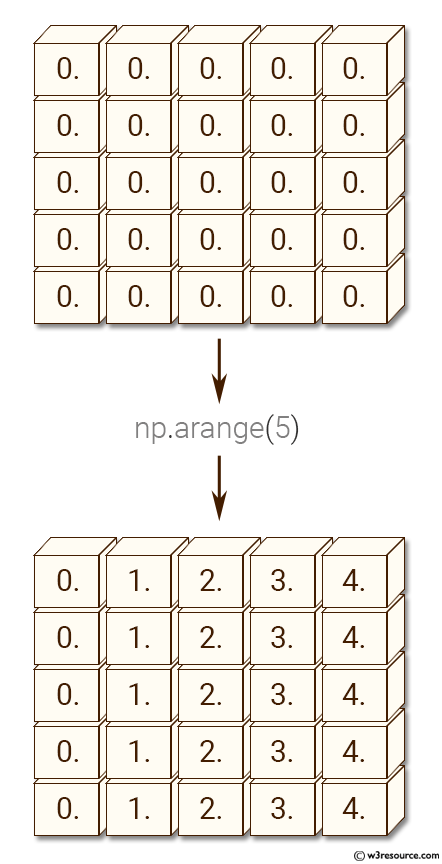NumPy: Create a 5x5 matrix with row values ranging from 0 to 4
5x5 Matrix with Row Values 0–4
Write a NumPy program to create a 5x5 matrix with row values ranging from 0 to 4.
Pictorial Presentation:

Sample Solution:
Python Code:
# Importing the NumPy library with an alias 'np'
import numpy as np
# Creating a 5x5 NumPy array 'x' filled with zeros
x = np.zeros((5,5))
# Displaying the original 5x5 array 'x' filled with zeros
print("Original array:")
print(x)
# Adding row values ranging from 0 to 4 to each row of the array 'x'
# The values range from 0 to 4 due to np.arange(5)
x += np.arange(5)
# Displaying the array 'x' after adding row values
print("Row values ranging from 0 to 4.")
print(x)
Sample Output:
Original array: [[ 0. 0. 0. 0. 0.] [ 0. 0. 0. 0. 0.] [ 0. 0. 0. 0. 0.] [ 0. 0. 0. 0. 0.] [ 0. 0. 0. 0. 0.]] Row values ranging from 0 to 4. [[ 0. 1. 2. 3. 4.] [ 0. 1. 2. 3. 4.] [ 0. 1. 2. 3. 4.] [ 0. 1. 2. 3. 4.] [ 0. 1. 2. 3. 4.]]
Explanation:
‘x = np.zeros((5,5))’ creates a 5x5 array filled with zeros and stores in the variable ‘x’.
x += np.arange(5): This line adds the elements of the 1D array np.arange(5) to each row of the 2D array ‘x’. The np.arange(5) function creates a 1D array of elements from 0 to 4. Due to broadcasting rules, the 1D array is automatically expanded to match the shape of the 2D array x, and the elements are added element-wise.
For more Practice: Solve these Related Problems:
- Write a NumPy program to create a 5x5 matrix where each row contains a sequence from 0 to 4 using np.tile.
- Generate a 5x5 matrix and replace each row with the sequence 0 to 4, verifying the result with np.arange.
- Create a function that constructs a matrix with repeating row patterns and validates uniformity across rows.
- Utilize np.reshape and np.repeat to form a 5x5 matrix where every row displays consecutive integers from 0 to 4.
Go to:
PREV : Count Non-Zero Elements in Array
NEXT : Check Values Present in Array
Python-Numpy Code Editor:
Have another way to solve this solution? Contribute your code (and comments) through Disqus.What is the difficulty level of this exercise?
Test your Programming skills with w3resource's quiz.
